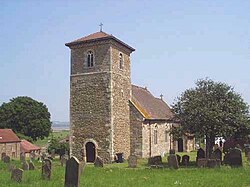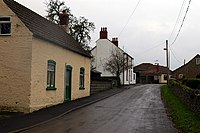Whitton, Lincolnshire: Difference between revisions
Created page with '{{Infobox town |name=Whitton |county=Lincolnshire |picture=Whitton Church (Lincolnshire).jpg |picture caption=St John the Baptist, Whitton |os grid ref=SE903244 |latitude=53.708 …' |
No edit summary |
||
| Line 15: | Line 15: | ||
|dialling code=01724 | |dialling code=01724 | ||
}} | }} | ||
'''Whitton''' is a village of about 166 inhabitants in [[Lincolnshire]]. It stands at the northern termination of the Cliff range of hills, on the south shore of the [[Humber]] about | '''Whitton''' is a village of about 166 inhabitants in [[Lincolnshire]]. It stands at the northern termination of the Cliff range of hills, on the south shore of the [[Humber]] about three miles below [[Trent Falls]], and nine miles west of [[Barton-upon-Humber]]. The parish is bounded on the west by [[Alkborough]], on the east by [[Winteringham]] (which also includes the Winteringham Haven Wildlife Reserve) and, to the south, by [[West Halton]]. | ||
==Historical remains== | ==Historical remains== | ||
Whitton may have originated at the time the Romans crossed the Humber northward in 71 | Whitton may have originated at the time the Romans crossed the Humber northward in AD 71; first as a military camp and then later as a Roman villa, overlooking the river, with its temple a few yards to the east, where the Church now stands. It is perhaps possible that Whitton was a landing stage on the south bank for the Roman fort and civitas of ''Petuaria Parisorum'' at [[Brough, Yorkshire|Brough]] across the river. Roman Coins of Claudius Gothicus (AD 268-270) and Constantine I (the Great) (AD 309-337) have been found in the fields. | ||
Pevsner reports that the Church tower "re-uses massive blocks of Roman stone",<ref name="pev">Pevsner, Nikolaus; Harris, John; ''The Buildings of England: Lincolnshire'', London, 1989, p. 797. ISBN 0-14-071027-2</ref> but these blocks of millstone grit which are to be found in several local churches (for example neighbouring [[Winteringham]]) may have been sailed down the [[River Ouse, Yorkshire|Ouse]] and the [[Humber]] from [[York]] where Roman buildings were being dismantled or may even have come from some sort of triumphal arch or structure (perhaps like the Arch of Constantine), which might have stood at the end of Ermine Street. | Pevsner reports that the Church tower "re-uses massive blocks of Roman stone",<ref name="pev">Pevsner, Nikolaus; Harris, John; ''The Buildings of England: Lincolnshire'', London, 1989, p. 797. ISBN 0-14-071027-2</ref> but these blocks of millstone grit which are to be found in several local churches (for example neighbouring [[Winteringham]]) may have been sailed down the [[River Ouse, Yorkshire|Ouse]] and the [[Humber]] from [[York]] where Roman buildings were being dismantled or may even have come from some sort of triumphal arch or structure (perhaps like the Arch of Constantine), which might have stood at the end of Ermine Street. | ||
| Line 25: | Line 25: | ||
==Parish church== | ==Parish church== | ||
The church is not mentioned in the Domesday Book. St John the Baptist is a building of stone, dramatically situated overlooking the [[Humber]], consisting of a west tower, a small nave 22 feet wide by 37 feet long with a | The church is not mentioned in the Domesday Book. St John the Baptist is a building of stone, dramatically situated overlooking the [[Humber]], consisting of a west tower, a small nave 22 feet wide by 37 feet long with a chancel and a south vestry attached. The partly Norman Romanesque tower contains three bells, now left untolled; the third bell is said to have been brought from the village of [[Welton, Yorkshire|Welton]], across the river in [[Yorkshire]]. | ||
The base of the tower forms a porch and the large tower arch, leading into the nave, is thought to be Romanesque. The baptismal font|font is also ancient and may be from the same period. The church seems to have been almost completely rebuilt in about 1797-8 when the elaborate crocketted pinnacles were removed from the top of the tower. A drawing, by John Claude Nattes, of 1794 shows a dilapidated structure with a south aisle and a south porch. | The base of the tower forms a porch and the large tower arch, leading into the nave, is thought to be Romanesque. The baptismal font|font is also ancient and may be from the same period. The church seems to have been almost completely rebuilt in about 1797-8 when the elaborate crocketted pinnacles were removed from the top of the tower. A drawing, by John Claude Nattes, of 1794 shows a dilapidated structure with a south aisle and a south porch. | ||
The church was reseated in 1865 at the expense of Lady Strickland, and between about 1892 and 1897 the nave, chancel and roof were entirely rebuilt from the designs of W. & C. A. Bassett-Smith, architects, of [[London]]. On the north side of the chancel are two stained-glass windows, erected in 1918 to the memory of Henry Spilman who was killed in the First World War. In 1952-53 cracks in the tower were repaired under the direction of A.R Haynes, architect of [[Brigg]]. | The church was reseated in 1865 at the expense of Lady Strickland, and between about 1892 and 1897 the nave, chancel and roof were entirely rebuilt from the designs of W. & C. A. Bassett-Smith, architects, of [[London]]. On the north side of the chancel are two stained-glass windows, erected in 1918 to the memory of Henry Spilman who was killed in the First World War. In 1952-53 cracks in the tower were repaired under the direction of A.R Haynes, architect of [[Brigg]]. | ||
==References== | |||
[[File:Whitton - Chapel Lane - geograph.org.uk - 106888.jpg|thumb|200px|Chapel Lane, Whitton]] | |||
{{reflist}} | |||
==Outside links== | ==Outside links== | ||
{{Commonscat|Whitton,_North_Lincolnshire}} | |||
*[http://www.genuki.org.uk/big/eng/LIN/Whitton/ "Whitton"], Genuki.org.uk | *[http://www.genuki.org.uk/big/eng/LIN/Whitton/ "Whitton"], Genuki.org.uk | ||
*[http://www.diplomate.freeserve.co.uk/whitton.htm "Whitton, Lincolnshire - notes on the history of a village"] | *[http://www.diplomate.freeserve.co.uk/whitton.htm "Whitton, Lincolnshire - notes on the history of a village"] | ||
*[http://www.northlincs.gov.uk/NorthLincs/Leisure/libraries/localstudies/localhistorypacks/Whitton.htm "Whitton Local History Pack"] (local authority) | *[http://www.northlincs.gov.uk/NorthLincs/Leisure/libraries/localstudies/localhistorypacks/Whitton.htm "Whitton Local History Pack"] (local authority) | ||
*[http://www.crsbi.ac.uk/search/location/whitton*/site/ed-li-whitt.html "St. John, Whitton, Lincolnshire"], The Corpus of Romanesque Sculpture in Britain and Ireland | *[http://www.crsbi.ac.uk/search/location/whitton*/site/ed-li-whitt.html "St. John, Whitton, Lincolnshire"], The Corpus of Romanesque Sculpture in Britain and Ireland | ||
Latest revision as of 09:30, 9 November 2017
| Whitton | |
| Lincolnshire | |
|---|---|
 St John the Baptist, Whitton | |
| Location | |
| Grid reference: | SE903244 |
| Location: | 53°42’29"N, -0°38’2"W |
| Data | |
| Population: | 171 (2001) |
| Post town: | Scunthorpe |
| Postcode: | DN15 |
| Dialling code: | 01724 |
| Local Government | |
| Council: | North Lincolnshire |
| Parliamentary constituency: |
Brigg and Goole |
Whitton is a village of about 166 inhabitants in Lincolnshire. It stands at the northern termination of the Cliff range of hills, on the south shore of the Humber about three miles below Trent Falls, and nine miles west of Barton-upon-Humber. The parish is bounded on the west by Alkborough, on the east by Winteringham (which also includes the Winteringham Haven Wildlife Reserve) and, to the south, by West Halton.
Historical remains
Whitton may have originated at the time the Romans crossed the Humber northward in AD 71; first as a military camp and then later as a Roman villa, overlooking the river, with its temple a few yards to the east, where the Church now stands. It is perhaps possible that Whitton was a landing stage on the south bank for the Roman fort and civitas of Petuaria Parisorum at Brough across the river. Roman Coins of Claudius Gothicus (AD 268-270) and Constantine I (the Great) (AD 309-337) have been found in the fields.
Pevsner reports that the Church tower "re-uses massive blocks of Roman stone",[1] but these blocks of millstone grit which are to be found in several local churches (for example neighbouring Winteringham) may have been sailed down the Ouse and the Humber from York where Roman buildings were being dismantled or may even have come from some sort of triumphal arch or structure (perhaps like the Arch of Constantine), which might have stood at the end of Ermine Street.
Whitton is mentioned in the 1086 Domesday Book as "Witenai".[2][3] Before the Norman Conquest the manor was held by Siward Barn, and after by Saswalo of Ettington, with Henry de Ferrers becoming Tenant-in-chief. Listed is 300 acres of meadow, land for eight ploughs, two plough teams belonging to the lord, five men's plough teams, ten villains, four bordars (smallholders) and ten freemen. The land was valued at seven pounds.
Parish church
The church is not mentioned in the Domesday Book. St John the Baptist is a building of stone, dramatically situated overlooking the Humber, consisting of a west tower, a small nave 22 feet wide by 37 feet long with a chancel and a south vestry attached. The partly Norman Romanesque tower contains three bells, now left untolled; the third bell is said to have been brought from the village of Welton, across the river in Yorkshire.
The base of the tower forms a porch and the large tower arch, leading into the nave, is thought to be Romanesque. The baptismal font|font is also ancient and may be from the same period. The church seems to have been almost completely rebuilt in about 1797-8 when the elaborate crocketted pinnacles were removed from the top of the tower. A drawing, by John Claude Nattes, of 1794 shows a dilapidated structure with a south aisle and a south porch.
The church was reseated in 1865 at the expense of Lady Strickland, and between about 1892 and 1897 the nave, chancel and roof were entirely rebuilt from the designs of W. & C. A. Bassett-Smith, architects, of London. On the north side of the chancel are two stained-glass windows, erected in 1918 to the memory of Henry Spilman who was killed in the First World War. In 1952-53 cracks in the tower were repaired under the direction of A.R Haynes, architect of Brigg.
References

- ↑ Pevsner, Nikolaus; Harris, John; The Buildings of England: Lincolnshire, London, 1989, p. 797. ISBN 0-14-071027-2
- ↑ "Documents Online: Whitton, Lincolnshire", Folio: 353v, Great Domesday Book; The National Archives]]. Retrieved 23 December 2011
- ↑ Domesday Book: A Complete Translation. London: Penguin, 2003. p.918 ISBN 0-14-143994-7
Outside links
| ("Wikimedia Commons" has material about Whitton, Lincolnshire) |
- "Whitton", Genuki.org.uk
- "Whitton, Lincolnshire - notes on the history of a village"
- "Whitton Local History Pack" (local authority)
- "St. John, Whitton, Lincolnshire", The Corpus of Romanesque Sculpture in Britain and Ireland
